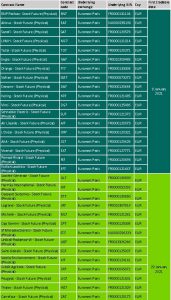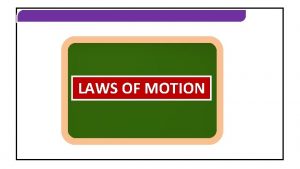10 Laws of List Generation The underlying principles













- Slides: 13

10 Laws of List Generation The underlying principles for successfully developing a killer list

1 The Law of Planning Define your goal • Define what data you need • Keep the big picture in sight • Create a list definition statement • Summarize the intended use of your list • Let it guide everything you do • Filter every aspect of your list creation through it

2 The Law of Standards Define your target standards The Container Company Incorporated The Container Company Inc The Container Co Incorporated The Container Co Inc The Container Company Inc. The Container Co. Incorporated The Container Co. Inc The Container Co Inc Container Company Incorporated, The Container Company Inc, The Container Company Incorporated Container Company Inc Container Co Incorporated The Container Company Container Co. Incorporated Container Co. Inc Container Co Inc. Container Company Inc. , The Container Co. Inc, The Container Co Inc. , The Container Company Inc. = Legal Name = Common Name

3 The Law of Permutation Cover all synonyms when searching There are many ways of saying the same thing There are many ways to say the same thing There are many ways for saying something There are many ways to saying something The Internet and disparate data sources are written in the language of the many and can not be encapsulated from one vantage point. You must therefore define your search in the language of the many. Build a comprehensive list of all variations. Director of Benefits Director Benefits Advisor Benefits Administrator Employee Benefits Manager Benefits Specialist Admin of Benefits Manager of Benefits

4 The Law of Taxonomy Uncover the Internal taxonomy • There are internal and external taxonomies • The External taxonomy is how you description • The Internal taxonomy is the target description External description: I need companies that make “Ophthalmic lasers” Internal description: I specialize in “Foldable intraocular” lasers for performing “Phacoemulsification” on “corneal microkeratomes”.

5 The Law of Iteration Test your hypothesis • Research is fluid and changing • If using the Internet, don’t treat it Internet like a database • Each piece of knowledge you learn affects your next query • Never rely solely on technology • Cycle through (test/adapt/test/adapt) until list results are consistent Iteration example: Finding manufacturing engineers. . . 1. First find out where they hang out 2. Create a list of those places and the variations of titles 3. Talk to a few experts & check your premises 4. Rework your search strategy accordingly. 5. Search again

6 The Law of Find Completeness your total available market (TAM) • First determine the total Companies/Accounts in your TAM • Take a random sample of Accounts, research all target titles and get an estimated count based on the sample size • Determine if your search is Company-First or Contact-First (niche or hard-to-find titles tend to favor contact-first method) • Understand the limitation of each search medium (i. e. google limited to 1000 results, Linked. In limits 800 -1000 per day) • If possible, work with all results from your search. • Understand diminishing returns when using Internet search.

7 The Law of Segmentation Record all significant attributes • Save any meta-data gathered while list building • Unique attributes will be critical for list segmentation • Analyze meta-data to select segmentation parameters • Pre-calculate and separate fields to speed future queries example: separate area code into it’s own field. Having data segmented exposes more information to more people without requiring technical skills. Data storage is cheap, development and custom report writing is expensive.

8 The Law of Frequency Establish an update cycle • Based on your sales process, determine a cycle for updating data • Tag all records with date-of-update • Archive each iteration of your generated list (old results may never be available again) • Understanding data decay frequency • Contact data degrades 3 -5% per month • Account data degrades 15% per year • Emails should be verified every 90 days • Social profiles should be refreshed yearly

9 The Law of. Document Process what does and does not work • Document • The next list you create can borrow from past experience. Document each step in creating your list. • Make sure your documentation is available to all stake-holders (sales, marketing, technology, operations, executive)

The Law. Measurement of Potential determines methology Accuracy Data Quality = + Timeliness Competitive = Advantage Targeted + Exclusive Data Potential Competitive advantage 10 Data quality Your data potential will determine what is possible to do with your data

Permutations vs Taxonomies Comparision cheatsheet Permutations are linear synonyms • Multiple combinations • Like things • Iterative • Diminishing returns Taxonomies eventually diverge from synonyms • Fluid • Creative • Iterative • Expanding returns

Do a free data assessment Strategic data assessment - quick survey that will uncover the underlying issues with your data. Get insights that would normally take a 4 -5 hour conversation with a data expert. http: //bit. ly/Data-assessment Dataset questionnaire - You have an existing list, but you need a strategy to make it better. Fill out the dataset questionnaire and let us know what you are dreaming about. http: //bit. ly/Dataset-questions You can also visit https: //dataz. co/strategic-data-assessment/
 Visual organization and interpretation
Visual organization and interpretation Underlying design
Underlying design First generation antipsychotics vs second
First generation antipsychotics vs second Lord you are good and your mercy
Lord you are good and your mercy Facts about montesquieu
Facts about montesquieu Threshold theory cummins
Threshold theory cummins Underlying theory in research
Underlying theory in research Militarism def
Militarism def Underlying cause and immediate cause
Underlying cause and immediate cause Underlying magic slide
Underlying magic slide Spoticash scam
Spoticash scam The underlying theme of the conceptual framework is
The underlying theme of the conceptual framework is Underlying causes of ww1
Underlying causes of ww1 M.a.i.n ww1
M.a.i.n ww1

























